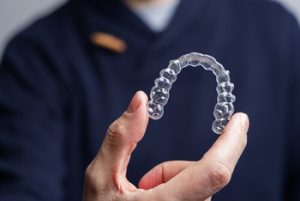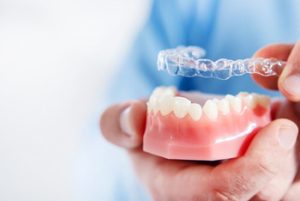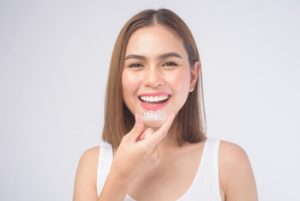In recent years, Invisalign, a cutting-edge orthodontic treatment, has surged in popularity, revolutionising how we approach dental health and smile aesthetics. But what is Invisalign? Essentially, it’s a series of clear aligners, virtually invisible, designed to straighten teeth discreetly and efficiently. Unlike traditional braces, Invisalign aligners are made from a unique SmartTrack material, offering comfort without the hassle of metal wires and brackets.
The Invisalign process begins with a consultation with a trained doctor, who develops a customised treatment plan based on X-rays and physical impressions of the patient’s teeth. These clear plastic aligners are then crafted to fit snugly over the teeth, gently moving them into the desired position over time. The flexibility of Invisalign aligners extends beyond their physical nature; patients can remove them for eating and cleaning, a significant advantage over traditional metal braces.
Understanding the nuances of Invisalign treatment is crucial for anyone considering orthodontic options. Whether dealing with crowded teeth, gap teeth, or an overbite, Invisalign offers a solution that balances effectiveness and aesthetics. Moreover, the cost of Invisalign treatment, while a consideration, is often comparable to traditional braces, and many dental care plans offer insurance coverage, with some even accommodating flexible spending accounts.
The growing trend towards Invisalign clear aligners reflects a broader shift in dentistry towards treatments that promote oral health and consider the patient’s lifestyle and comfort. This approach aligns technology with the personal needs of patients, ensuring an improved smile without the discomfort and self-consciousness often associated with regular braces. As we delve deeper into the Invisalign treatments, it becomes evident that they represent a key step in modern dentistry, offering a blend of innovation, efficiency, and patient-focused care.
What is Invisalign?
Invisalign, a modern twist in orthodontic treatment, has become popular for those looking to straighten their teeth while avoiding the discomfort and visibility of traditional braces. So, what is Invisalign exactly? It’s a series of clear aligners crafted from a proprietary SmartTrack material, designed to adjust teeth alignment gently and effectively. Unlike traditional metal braces, Invisalign clear aligners are virtually invisible, offering an aesthetic advantage, especially appealing to adults and teens who may feel self-conscious about orthodontic treatment.

Invisalign’s development history dates back to the late 1990s, marking a significant leap in dentistry. It offered a solution to many drawbacks associated with regular braces, such as metal wires and brackets, which can cause discomfort and require frequent emergency visits for broken wires. Invisalign aligners fit comfortably over the teeth, are removable for eating and cleaning, and require fewer check-ups, making them a convenient option for many patients.
Invisalign treatment costs are comparable to traditional braces, with many dental care plans offering insurance coverage or flexible payment options. Though seemingly simple, the Invisalign process involves intricate planning and precision, ensuring each aligner works effectively towards creating a new smile. This process makes Invisalign a preferred choice for teeth alignment, offering an improved smile without the visible hassle and discomfort of traditional brackets and wires.
The Invisalign Treatment Process
Invisalign, a revolutionary approach to orthodontic treatment, has transformed how we think about aligning teeth. Unlike traditional braces, Invisalign clear aligners offer a virtually invisible way to correct dental imperfections. Here’s a comprehensive look at the Invisalign process, from the initial consultation to the final results.
Initial Consultation and Dental Assessment
The journey to a new smile begins with an initial consultation with a trained doctor. During this session, the dentist assesses your dental health, including any issues like crowded teeth, gap teeth, or overbite. Utilising X-rays and physical impressions, your dentist will determine if Invisalign aligners suit your teeth’ alignment needs. This key step ensures that each patient receives a customised treatment plan tailored to their unique oral health requirements.
Customisation: Crafting a Unique Treatment Plan and Aligners
Following the assessment, your dentist creates a customised treatment plan. This plan includes a detailed roadmap of how the Invisalign aligners will move your teeth into the desired position. Using Align Technology’s SmartTrack material, each set of clear plastic aligners is precisely manufactured to fit snugly over your teeth, ensuring comfort and effectiveness.
The Step-by-Step Process: From Start to Finish
The Invisalign treatment involves wearing a series of aligners, each slightly different from the last, to shift your teeth into place gradually. Unlike traditional metal braces, Invisalign clear aligners are removable, offering flexibility and ease in maintaining oral hygiene and enjoying meals. Patients typically wear each set of aligners for about two weeks before moving to the next in the series.
Regular check-ups with your dentist are essential throughout the treatment to monitor progress and make any necessary adjustments. The duration of Invisalign treatments varies depending on the case’s complexity, but many patients see noticeable improvements within a year.
In terms of cost, Invisalign treatment costs can be comparable to traditional braces. However, insurance coverage, payment plans, and flexible spending accounts can influence the final Invisalign cost.
Advantages of Invisalign Over Traditional Braces
Invisalign, a revolutionary development in orthodontic treatment, offers several advantages over traditional braces, making it a preferred choice for patients seeking teeth alignment solutions. Understanding these benefits can help individuals make an informed decision about their dental health.
Aesthetics: Virtually Invisible

Comfort: Less Irritation
Comfort is another crucial advantage of Invisalign over traditional braces. Invisalign aligners, made from smooth, clear plastic, reduce the risk of irritation to the gums and cheeks commonly associated with metal braces. This comfort is especially beneficial for patients with sensitive mouths or those who experience discomfort from the metal wires and brackets of regular braces.
Convenience: Removable for Eating and Cleaning
Invisalign’s removability is a game-changer in orthodontic treatments. Patients can easily remove their aligners for eating, brushing, and flossing, ensuring better oral health throughout the treatment. This convenience is impossible with traditional braces, where food particles can become trapped, and cleaning around wires and brackets can be challenging.
Duration: Efficient Treatment Times
Regarding treatment duration, Invisalign can be more efficient than traditional braces. While treatment times vary depending on the individual’s needs, many patients find that Invisalign works to straighten their teeth in a shorter period. This efficiency is due to the advanced technology and customised treatment plan devised for each patient, ensuring each set of aligners effectively moves the teeth towards the desired position.
In conclusion, Invisalign offers a blend of aesthetics, comfort, convenience, and efficiency, making it a highly desirable option for orthodontic treatment. With its clear aligners, patients can achieve their desired teeth alignment and smile with minimal disruption to their daily lives.
Effectiveness and Limitations
Invisalign has revolutionised orthodontic treatment with its clear aligners, providing an effective solution for various dental issues while offering aesthetic and comfort advantages over traditional braces. However, it is crucial to understand its effectiveness and limitations for patients considering this treatment.
Effectiveness: Dental Issues Invisalign Can Treat
Invisalign aligners are highly effective in treating a range of orthodontic issues. They work exceptionally well for crowded teeth, gap teeth, and mild to moderate cases of overbite, underbite, and crossbite. The aligners, designed using advanced Align Technology, are customised for each patient, ensuring a precise fit and effective teeth alignment. Through a series of aligners, Invisalign gradually moves the teeth into the desired position, contributing to an improved smile. The success rate of Invisalign treatments is high, with many patients achieving their desired results within the estimated treatment time.
Limitations: When Traditional Braces Might Be Better
While Invisalign is versatile, traditional metal braces may be more suitable in some cases. Severe orthodontic problems, such as extreme overcrowding or complex bite issues, require the more robust force and control traditional braces offer. In situations involving interproximal reduction or significant tooth rotation, the precision of metal brackets and wires might be necessary to achieve the desired outcome.
Scientific Evidence and Success Rates
Numerous studies have supported the effectiveness of Invisalign. These studies highlight the high success rates in achieving teeth alignment goals, especially in mild to moderate cases. However, the effectiveness also depends on patient compliance; wearing the aligners for the recommended 20-22 hours daily is crucial for success.
In conclusion, Invisalign offers a highly effective and aesthetically pleasing option for orthodontic treatment, suitable for various dental issues. While there are limitations to what Invisalign can achieve, especially in more complex cases where traditional braces might be preferable, its success in enhancing dental health and smiles is well-documented and widely acknowledged.
Maintenance and Aftercare
Maintaining your Invisalign aligners is crucial for the success of your orthodontic treatment. A daily care routine ensures that your aligners stay clean and effective. Rinse your Invisalign clear aligners every night and brush them gently with a soft toothbrush. Avoid using hot water, as it can warp the plastic. Maintaining good oral health by brushing and flossing your teeth regularly is also important. This helps prevent issues like tooth decay and gum disease, which can affect treatment.
After completing the Invisalign treatment, post-treatment care is vital to maintain your new smile. Your dentist will likely recommend retainers to ensure your teeth stay in their new position. These retainers are similar to Invisalign aligners but are designed for long-term use. Initially, you might need to wear them most of the day, but over time, you’ll only need to wear them at night.
Remember, the success of the Invisalign process depends on the aligners and how well you take care of your teeth and the aligners throughout the treatment. Regular check-ups with your dentist are essential to monitor your progress and make any necessary adjustments. Following these guidelines allows you to enjoy a straightened, improved smile for years.
Cost and Insurance Considerations
Understanding the cost and insurance coverage is vital when considering Invisalign for orthodontic treatment. The general cost range of Invisalign treatment varies, but it is often comparable to traditional braces. Factors influencing the cost include the complexity of the teeth alignment issues and the duration of the treatment. On average, Invisalign treatment costs can be slightly higher than traditional metal braces due to the advanced technology and custom aligners used.

Additionally, many dentists offer flexible payment plans to make Invisalign treatments more affordable. These payment options often allow patients to spread the cost of the treatment, making it easier to manage financially. Some patients also utilise flexible spending accounts (FSAs) or health savings accounts (HSAs) to pay for their Invisalign aligners, using pre-tax dollars to save on the overall cost.
While the cost of Invisalign might seem daunting initially, the combination of insurance coverage, flexible payment options, and the benefits of clear aligners regarding dental health and aesthetics make it a worthwhile investment for many patients seeking a new smile. It’s always recommended to discuss with your dentist to get a detailed treatment plan and understand the exact costs and payment options available.
Conclusion
In summary, Invisalign represents a significant advancement in orthodontic treatment, offering a range of benefits over traditional braces. What is Invisalign? It’s a modern solution for teeth alignment, leveraging clear, virtually invisible aligners, providing an aesthetic edge for those conscious about their smile during treatment. The comfort of Invisalign aligners, with their custom fit and less irritation than metal brackets, makes the process more manageable and less intrusive.
The convenience of Invisalign, especially its removability for eating and cleaning, addresses many of the challenges associated with traditional braces. This feature not only improves oral health during treatment but also aligns with the busy lifestyles of many patients. While Invisalign might have some limitations in treating severe orthodontic cases, its effectiveness in a wide range of situations, backed by Align Technology, is undeniable.
Cost and insurance considerations are important aspects of choosing Invisalign treatments. With options for flexible spending accounts, payment plans, and often comparable costs to traditional braces, Invisalign is accessible to a broader patient base. Moreover, many dental insurance plans cover a portion of the Invisalign cost, further easing the financial burden for patients.
When choosing the right dental alignment treatment, it’s essential to consider all factors – from aesthetics and comfort to cost and effectiveness. Invisalign offers a balanced solution, addressing many drawbacks of traditional metal braces.
For those interested in exploring Invisalign to improve their smile, visiting Woonona Dentists can be the first step towards a new, confident smile. The trained doctors at Woonona Dentists can provide a detailed consultation, helping you understand the Invisalign process and develop a personalised treatment plan. To learn more about how Invisalign works and to discuss your specific needs, call Woonona Dentists at (02) 4208 0623. Embrace the opportunity to transform your smile with the latest in orthodontic technology.
References:
www.medicalnewstoday.com/articles/teeth-retainer.
https://assets.ctfassets.net/y75jnaifzz4q/7niBLWjMLWLWK7LqtOhzT2/93b91508f142b1a607bd5239b865b3b5/Invisalign_Patient_IFU_207020_Rev_D_Clean.pdf
https://www.healthline.com/health/does-invisalign-work
https://iaoi.pro/asset/files/jdo_54_pdf_article/080_095.pdf
https://www.webmd.com/oral-health/invisible-orthodontic-aligners





